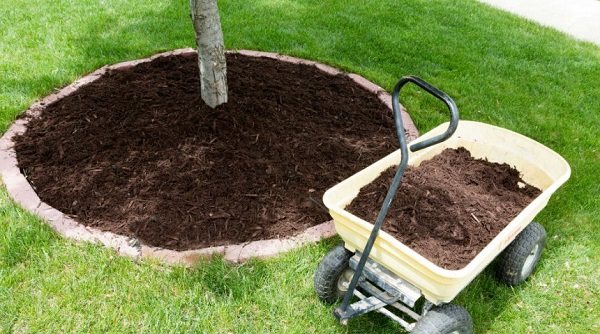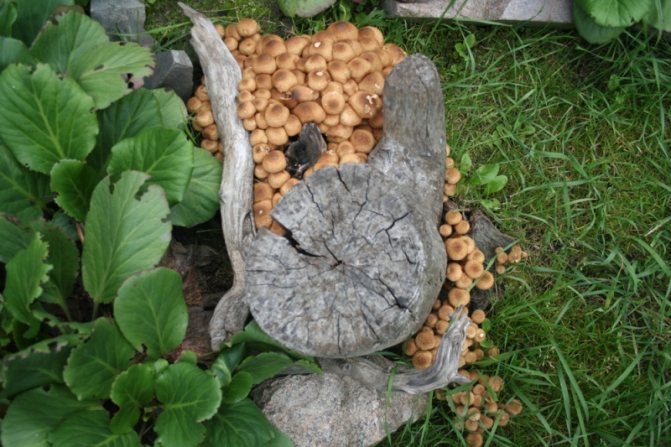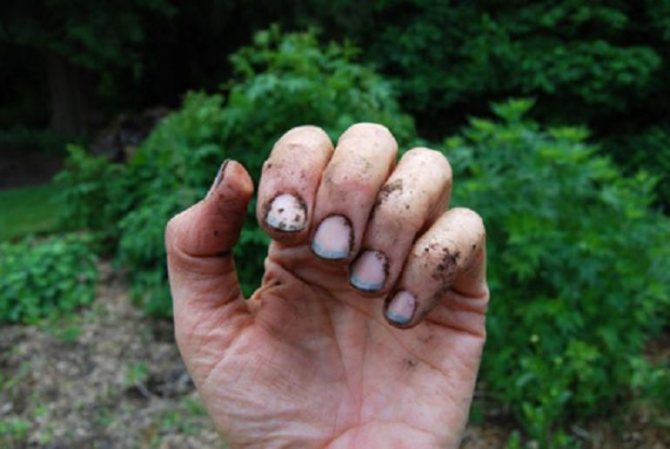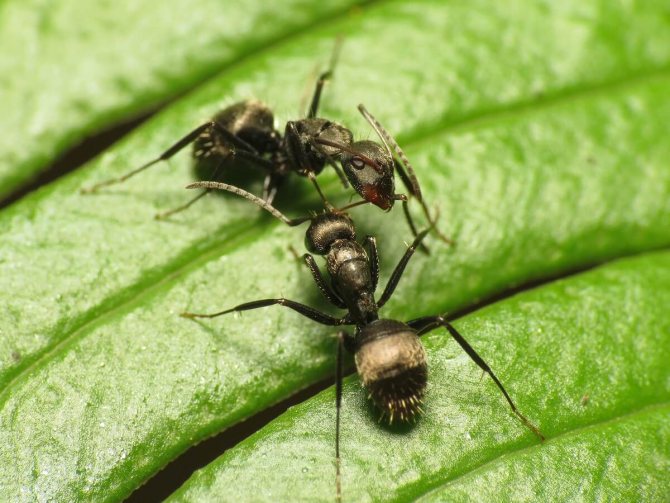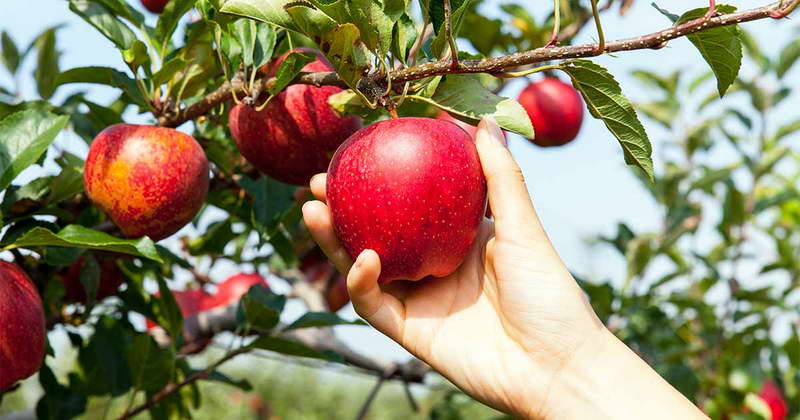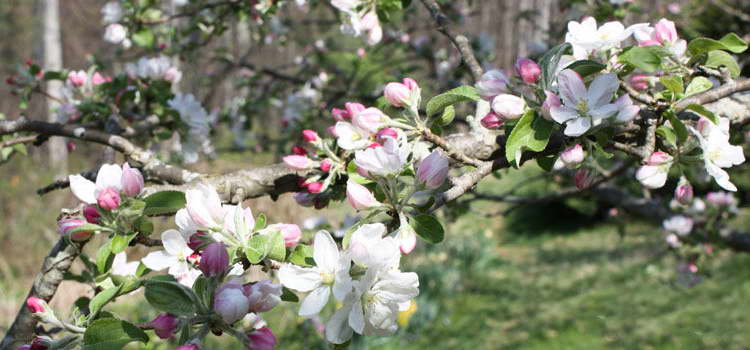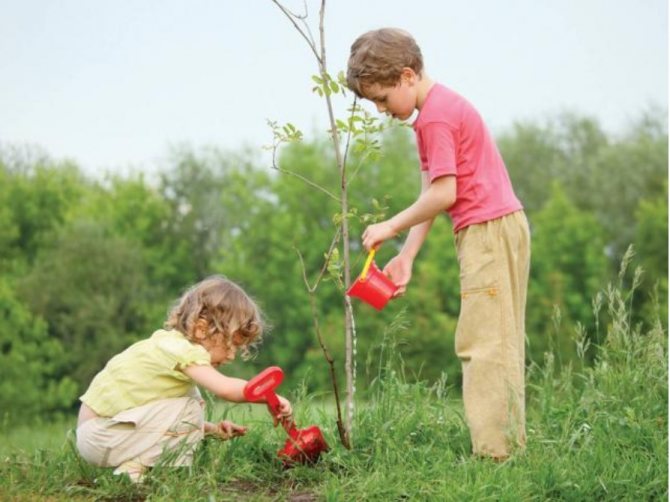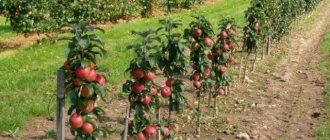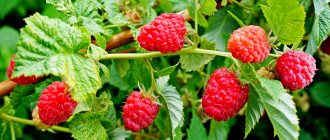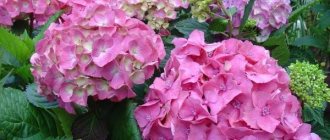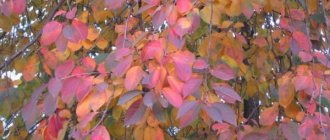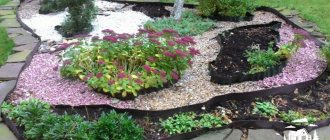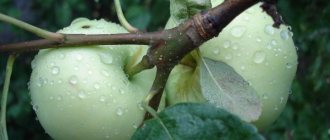It is unlikely that there is at least one household plot on which this unpretentious and unusually productive tree would not grow. Due to their ease of care, apple trees grow in almost any region of Russia. But not every gardener pays due attention to them in the fall. Most are limited to harvesting and gardening. Few people know that, in addition to the obligatory annual work, it is necessary to help the trees accumulate nutrients and prepare for winter. And feeding the apple trees in the fall will help in this.

Fertilizers
Components that are used to replenish nutrients in the soil can be:
- Organic origin (bird droppings, manure, peat, compost material).
- Mineral origin (nitrogen - carbamide or urea, potassium - potassium salt, phosphorus - superphosphates).
- Complex a set of organics with the addition of mineral fertilizers.
The most valuable fertilizers are considered organic, since they contain all the essential nutrients required for apple trees. In addition, they improve soil structure:
- Make it looser;
- Increase oxygen access to the root system;
- The soil composition itself improves.
Mineral fertilizers are used to deliver only one specific substance to the plant (phosphorus, potassium or nitrogen).
Most of the fertilizers are applied during the autumn period. Of the minerals, it is recommended to use only phosphates and potash fertilizers.
How to feed apple seedlings when planting in spring or autumn
The easiest and most convenient way to provide young seedlings with the necessary substances for the next 2 years is to add mineral fertilizing to the planting pit, mixing them with earth. For one seedling, it is enough to add 5-6 tablespoons of nitroammophoska. This complex fertilizer contains all the components necessary for growth: nitrogen, potassium and phosphorus. After planting, mulch the soil with humus, compost, or even a layer of leaves, straw. Organic matter will be an excellent fertilizer and will create favorable conditions in the soil itself.
Instead of nitroammophoska, when planting seedlings in the fall, you can add 500-600 grams of double superphosphate and 200-250 grams of potassium salt.
How to prepare apple trees for fertilization?
Fertilizing apple trees is best done in late August or early September.. Since at this time the trees are still green and there is an active consumption of nutrients, it is necessary to prepare the apple trees for the coming winter.
Before fertilizing, you must first conduct a general inspection of all fruit trees and, if necessary remove overgrown moss and lichens from the trunks.
This will avoid premature drying of the branches. The cleaned trunks must be treated with a solution of copper sulfate, and then smeared with garden varnish.
Common mistakes
When applying fertilizers, gardeners have the best expectations, but quite often all efforts are canceled out by mistakes. You can harm not only the crop, but also the tree.
To avoid disappointment, you need to know the common mistakes:
- Organic fertilizers should be applied when the soil has completely thawed; in cold soil, they will lose their beneficial effect.
- Organic matter should not be abused, since it is possible to provoke the development of fungal diseases (especially during prolonged rainy weather). Alternate with complex mineral fertilizers.
- If the spring is dry, it is better not to use dry mixtures for feeding trees.
- In the spring, it is necessary to add to the soil the entire norm of nitrogen to activate growth and successfully build up green mass. At a later date, such fertilization cannot be applied, since this will negatively affect the yield.
- Foliar treatment can only be carried out on mature plants. To protect the leaves from burns, carry out a trial treatment.
- Fertilize at the root should be done only on wet soil.
- If the leaves curl and fall off, the tree sheds the ovary, this indicates a lack of potassium. In this case, carry out a purely potassium-phosphorus feeding.
Trees grow and more nutrients are consumed every season. To ensure regular fruiting and increase the life of the crop, fertilization will be required. Spring feeding of apple trees is key. Having done some simple manipulations, you will get a rich harvest of high-quality, healthy and tasty fruits.
How to properly feed an apple tree in autumn - technology
After the trunks of the apple trees have been processed, you can begin to replenish the nutrients. In August, in order to better set the buds for the next year, it is best to feed with such a mineral fertilizer, like superphosphate... To do this, dissolve 100-150 grams of superphosphate per 10 liters of water and spray the green leaves of the apple tree with this solution.
If it was not possible to fertilize the apple tree through the leaves for some reason, then this can be done through the root system by introducing organic or mineral components.
Barrel fertilization method
Usually, all gardeners fertilize their apple trees by scattering fertilizer around the trunk circle, and then digging the soil onto the floor with a bayonet to a depth of no more than 20 cm.
If manure is used as a fertilizer for an apple tree in the fall, then it must necessarily be good rotted.
Up to two buckets of rotted manure are used for one apple tree trunk circle, which must be scattered over the entire trunk circle and dug to a depth of 20 cm.
This method of introducing organic matter will not only replenish the soil structures with nutrients, but also get rid of parasites.
After all, when digging, all the passages and shelters of various harmful microorganisms are violated. It is recommended to spill the dug manure well with water.
This is necessary in order for nutrients to quickly penetrate into the deeper layers of the soil and begin to be absorbed by the root system of the apple tree.
Hole fertilizer
In addition to the near-stem method, many gardeners use hole method of feeding apple trees fertilizers in the fall. In order to make a hole, it is necessary with a shovel to make a depression of no more than 20 cm around the perimeter of the apple tree crown. At the bottom of the hole, half the dose of the applied fertilizer is placed.
For example, if minerals are used (granular superphosphates, potassium salt), then about half a glass will go away. After the fertilizer is at the bottom of the hole, it must be mixed with the ground using the same shovel. This is done so that the fertilizer disperses as quickly as possible and the apple tree begins to be absorbed.
Planting apple trees in the fall in the Leningrad region. The process of planting an apple tree in autumn
The day before planting the seedling in a permanent place, it is placed in water. Take a close look at the bark of the sapling below. The place where the color of the bark is slightly darker is the root collar. When planting, it is sprinkled with earth a little, but when the soil settles, it should be about 6 cm above the soil level.
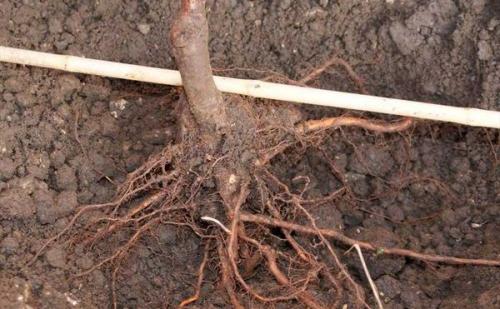

Root collar
It is strongly discouraged to tamp the earth after completing the landing procedure.In dense soil, the roots will not be able to breathe. After planting, tie the apple tree to a peg. This will protect it from damage.
Below we present the entire process of planting seedlings with an open root system in the desired sequence:
- In the prepared recess, make a hole the same diameter as the root system of the plant being planted. Water liberally and wait until the moisture is absorbed.
- Next, you need to inspect the roots of the seedling and cut off all rotten and injured areas with a secateurs.
- The seedling is placed in a recess near the support and the roots are covered with soil mixture, after which they are lightly tamped.


- Tie the plant to the peg with twine so as to give it the desired position. To prevent damage to the bark from possible friction due to wind, insert roofing material between the twine and the bark.
- Water the seedling very well. Usually 20 liters of water is poured out.
- Cover the area around the stem of the seedling with humus. This will prevent the loss of moisture from the soil from evaporation.
If a seedling is planted at the age of 1 year, then it is recommended to cut off its top, leaving a stem 75 cm high. And for a seedling aged 2 years, the lateral branches should be made shorter. This will lay the foundation for the formation of the crown.
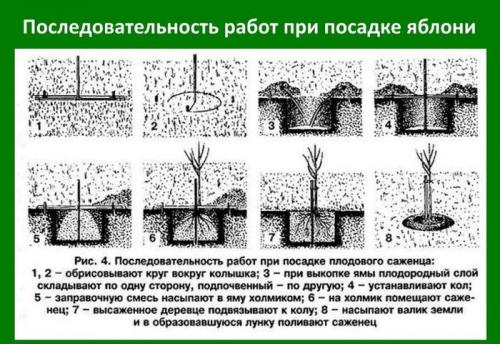

Watering the tree trunk circle
For large trees, it is necessary to ensure that the soil is moistened at least 1 meter deep. This is a high water consumption. It is recommended to combine feeding the apple trees after harvesting with watering. For this:
- Dig up the soil under the tree, focusing on the size of the crown. Along the edge of the digging, make a 50 cm depression so that the water does not spread.
- Pour out at least 200 liters of water - it is better to use a hose and a pump, so as not to carry water in buckets. Wait until the liquid is completely absorbed.
- Mix phosphorus-potassium fertilizers, than you need to feed the apple trees in the fall, and scatter them evenly over the dug area.
- Pour another 100 liters and mulch the earth, to retain moisture.
How to feed an apple tree while pouring fruits
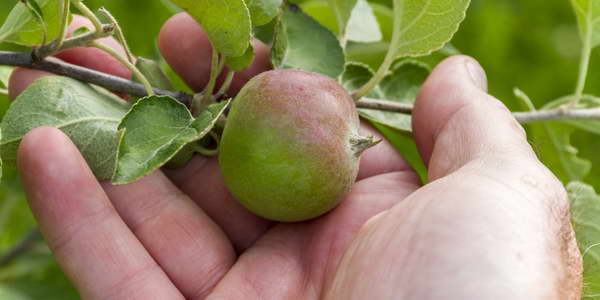

How to properly feed apple trees for a rich harvest
It so happens that in the spring time was lost, and you did not take care of the apple orchard. The apples are tied, but some are small, and the trees themselves look emaciated. In this case it is really worth helping the garden. First, make sure your apple trees are regularly and abundantly watered. Moisture will give a good incentive to pour apples, and the leaves will stop turning yellow and crumble.
The second step is feeding. Keep in mind that after applying mineral fertilizing, you cannot eat the crop for at least 3-4 weeks. Calculate the period, if there is enough time, you can use potash and phosphorus mineral compositions:
- For 10 liters of warm water, take 2 tbsp. tablespoons of superphosphate and 1 tbsp. spoon of potassium sulfate, stir thoroughly until completely dissolved.
- Spray on the leaves in the afternoon to prevent sun burns and rapid evaporation.
Fruit tree bark processing
In order for the apple tree to feel good in the spring and bear fruit in the fall, during feeding, you need to clean the bark of moss, lichens, examine the bark for the presence of pests.
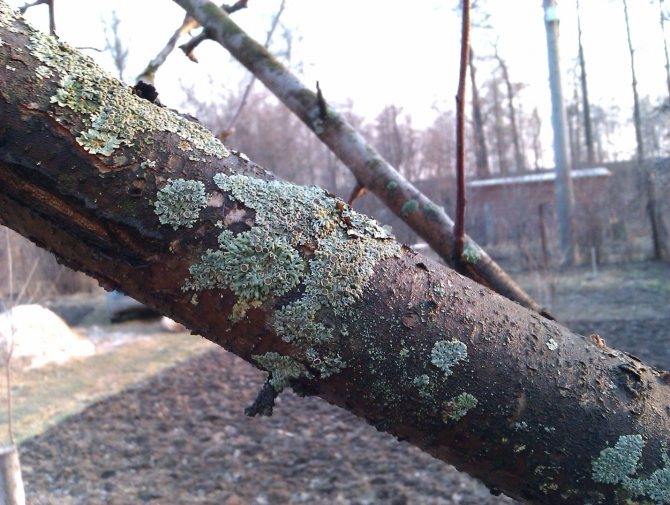

Moss is removed from the bark with an iron brush, then the places are treated with copper sulfate. The same is done if wintering pests are found under the bark - they are sprayed with vitriol. If the old bark has been badly damaged by insects, it is better to destroy it along with them. Bare wood is disinfected with vitriol, and then smeared with garden varnish. This mixture protects damaged areas from moisture loss from the inside and external influences. In winter, these are temperature changes and frost.
Home garden recipe
Required:
- 1 part rosin;
- 1 part beeswax
- 500 g of flaxseed oil;
- furnace ash - 1 part.
Procedure:
- Melt rosin and wax, mix.
- Add linseed oil and ash, mix.
If you add 10% of zinc oxide by volume to the mixture, you get a frost-resistant putty. It is impossible to replace linseed oil with any other.


Garden pitch is used to putty cuts and stripping on the bark. If the farm has cow dung and clay, then these two ingredients are mixed in equal proportions, water is added. The mixture should look like thick sour cream. She putty the trunk in places of damage to the bark and wrap it with rags for a year. The next year, in the fall, the tree is examined and, if necessary, the procedure is repeated.
Whitewashing apple trees
For whitewashing, use a solution consisting of lime, wood glue and copper sulfate:
- Dissolve 5 kg of lime, 1 kg of vitriol and 500 g of glue in 20 liters of water.
- Stir well and let stand for a couple of hours.
It is necessary to whitewash the trunks in dry weather so that the solution dries immediately.
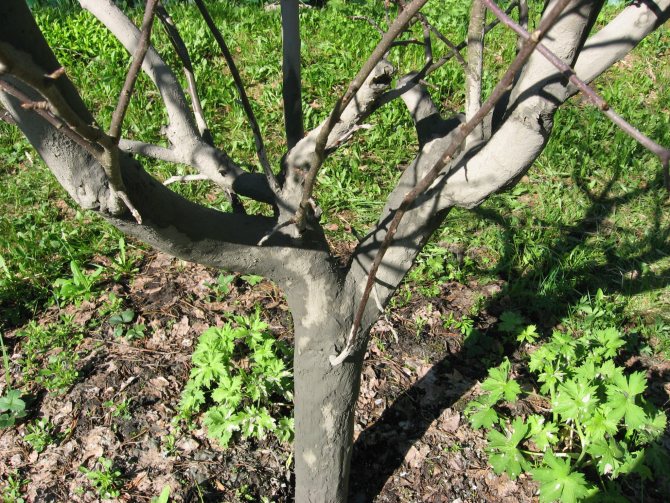

If the leaves have completely fallen off, then the branches are sprayed with urea so that the tree does not get sick with scab. You need to dissolve 500 g of urea in a bucket of water. Helps fight fungus and Bordeaux liquid 3% concentration: for a bucket of water 300 g of copper sulfate and 400 g of slaked lime. You need to spray with a mask and gloves.
Warming of the bark and protection from rodents
After whitewashing, the apple tree is wrapped in material or thick cardboard. This will protect young trees from freezing and damage by animals. After winding the barrel, the material is secured with tape or rope. If the barrel is not whitened, then the lower part of the winding must be sprinkled with earth and pressed down.
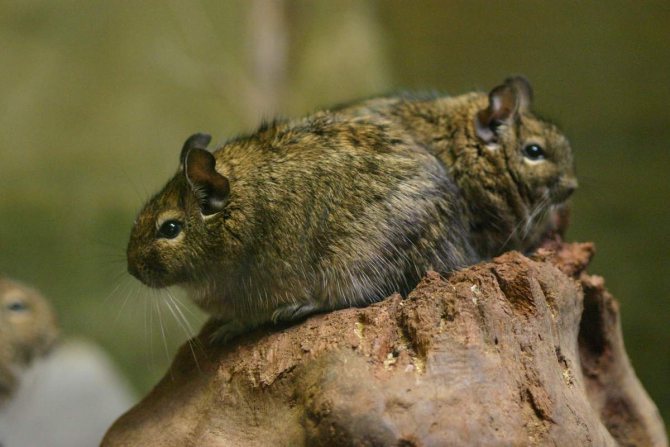

How to feed an apple tree during fruit ripening and fruiting
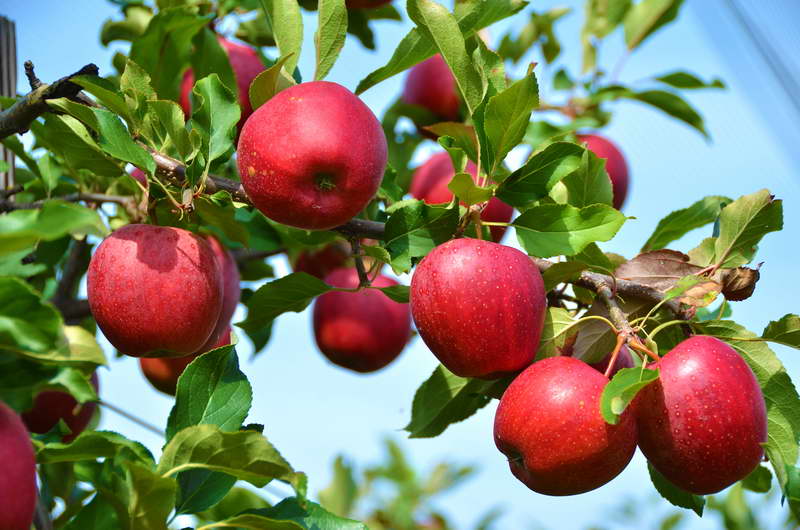

What fertilizers to feed apple trees for a rich harvest
When the apples are gradually ripening and the harvest is already partially removed, it is absolutely impossible to use mineral fertilizing. Only organic matter will help to get out of the situation: feed the apple trees in the evening with infusion of fermented bird droppings or mullein.
How to feed apple trees with manure or droppings
To obtain fermented chicken manure or cow dung concentrate, simply fill the organic matter with water so that it only slightly covers it. After 2 weeks, the thick slurry is diluted: they take 0.5 liters of droppings per bucket of water, 1 liter of manure. Under one adult apple tree, you can add from two to 4 buckets of such feeding. For young, 1 bucket is enough.
Fermented grass feeding
Fermented grass feeding will also bring good results. Also fill the green grass without seeds with water, ferment for two weeks and dilute 1 liter of concentrate in a bucket of water.
Ash feeding
Ash is a natural source of potassium and phosphorus, which can be safely used to fertilize the garden even during the fruiting period. To get an ash infusion, measure out 3 liters of ash, fill it with 10 liters of water, stir and leave closed for two days. Next, dilute 1 liter of infusion into a bucket of water and spray over the leaves. You can apply the solution at the root, then pour 4-6 buckets of such feeding under one adult tree.
How to fertilize an apple tree in autumn
Autumn feeding of an apple tree in winter consists in incorporating potash-phosphorus fertilizers into the soil. Nitrogen ones are not used, as they stimulate the formation of greenery and the tree does not winter well. Young apple trees with such feeding in the fall may even die in frost.
About 100 g of superphosphates, 100 g of potash fertilizers for apple trees in the fall are applied per 1 square meter. Rotten manure is also good, as it will take time to rot. Nitrogen from manure will not interfere with the wintering of trees.
After harvesting in the fall, apple trees are fed with the contents of a compost heap, if there is one in the country. After laying the nutrient mixture under the trees, it is advisable to mulch the place so that the substances do not erode and are not washed out by rains.


When planting apple trees in the fall, fertilizers are applied directly to the hole, a bucket of water is poured into the same place and a seedling is dropped in. Mineral fertilizers are mixed with the soil or a layer of soil is made between the fertilizer layer and the roots.
How to feed apple trees in the fall so that they bear fruit if there is no manure: the cheapest way out is green manure. You can cut clover, lupine, nettle, alfalfa in the field or on the site. One thing is sure to grow nearby and you can use it for your own purposes. The green mass is crushed and dug up in the trunk circle. During the winter, plant residues rot and serve as food for the roots.
After burning branches and leaves, ash remains, in which the record high content of phosphorus, potassium and calcium. Soil bacteria love ash, so applying it under fruit trees will result in an increased yield next season. You can feed the apple tree in autumn with dry ash or an extract.
Features of wintering apple trees
The apple tree is one of the most frost-resistant fruit trees. Many varieties overwinter at -40–45 ° C without much damage to themselves. This applies to wood, roots, and growth buds. In addition, the tree quickly recovers during the next season, even if it has suffered from frost.
But there are also varieties that are damaged even at -25 ° C. Based on the varietal characteristics and characteristics of the local climate, it is determined whether it is necessary to cover the tree for the winter, and if so, how carefully.
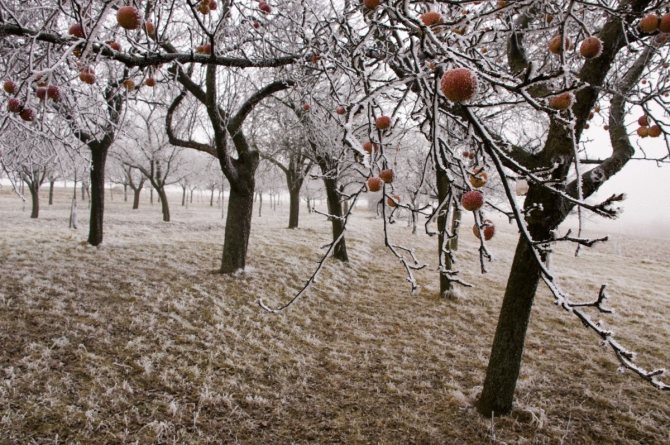

Frost resistance of some varieties of apple trees allows them to winter without damage in the Urals, Siberia, the Far East, but there are also much less cold-resistant varieties
What is the autumn feeding of the apple tree for?
Many novice summer residents mistakenly believe that there is no point in autumn dressing, because the plant is retiring. However, feeding the apple tree in the fall is included in the list of recommended and mandatory measures to prepare the tree for winter.
By the way! Right harvest apples and lay them for long winter storage will help you next material.


Actually, the need for annual autumn fertilization of apple trees is due to the fact that before winter the trees must strengthen your root systemso to speak increase winter hardiness (especially it concerns young trees), so that they can more easily withstand strong drops in temperature (frost), as well as increase the immunity of trees, their resistance to various kinds of diseases.
How to properly feed apple trees: types and rules
Note! In the fall, the apple tree requires only phosphate-potassium fertilizers, no nitrogen.
Root dressing - fertilizers are applied directly under the root of the plant, that is, in its near-stem circle (along the perimeter).


The most effective way to apply fertilizer in the fall under an apple tree
Root dressing can be liquid (fertilizers are pre-dissolved in water) or dry (scattered around the trunk circle). At the same time, dry dressing is convenient to carry out during the rainy seasons, for example, in the same autumn. However, as for young trees, it is better to feed them with liquid solutions.
Foliar dressing - fertilizers are applied through the aerial part of the tree, that is, through the surface of the leaves by spraying them.


Note! As a rule, foliar feeding of the apple tree is not carried out in the fall, except that it is done autumn eradication treatment (spraying) from pests and diseases... For this you need, for example, inkstone... But already during spring processing any copper preparations - the same copper sulfate or bordeaux liquid, or special drugs - "Hom", "Oksikhom", as well as "Horus", "Skor", "Ordan", etc.
When you do root dressing, fertilizer needs to be applied not under the barrel, but necessarily stepping back from the tree by 50-70 cm... It is at this distance that the roots of the tree are located, which you want to feed. At the same time, it is more rational to bury fertilizers in the soil in small doses, or simply scatter them around the perimeter (diameter) of the crown, then digging up a shovel 1/2 bayonet (10-15 centimeters).
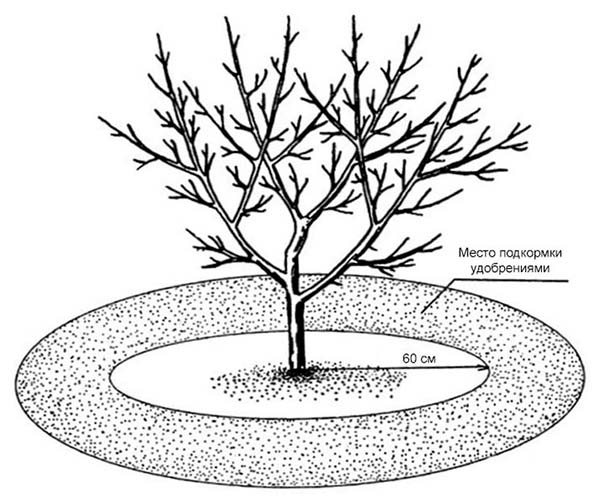

Important! Fertilization can only be done on wet soil, so the tree should be watered before and after fertilizing.
When to feed the apple tree in the fall: optimal timing
The last feeding of the apple tree in the season is carried out at the very beginning of autumn, after the harvest, when the soil is still warm and the plant is still awake (the root system works fine), that is, before the onset of frost, at least 2-4 weeks.
But better immediately after fruiting and harvesting.
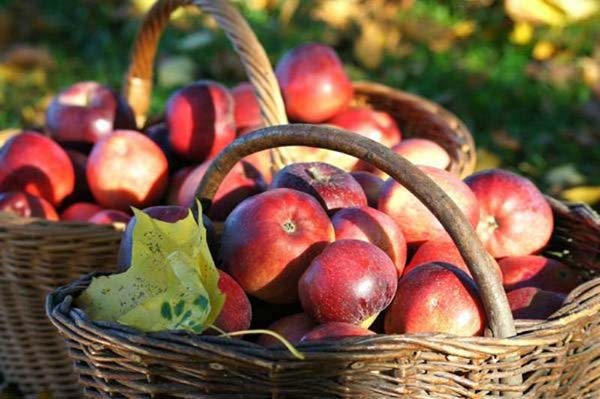

Shortly speaking, approximate terms of autumn feeding of apple trees - this is second half of August - September... In the Urals and Siberia - early, in the Middle Lane (Moscow region) - a little later, in the South the event is sometimes postponed even to October.
When is the best time to feed young trees
Top dressing will help strengthen the plant, prepare it for wintering. Application terms - from the end of August, so that the apple trees have time to assimilate vitamins and minerals before the onset of frost. This will help the tree to bear fruit better for the coming season.
Cold soil will not allow the root system to function normally.
The roots will not absorb nutrients quickly. It will take about a month for the apple trees to assimilate the necessary substances from the feeding. Therefore, in August, when the ground is still warm, trees will be able to obtain the necessary substances for wintering.


Fertilizing before the autumn planting of a young apple tree seedling
Features of feeding young and old apple trees in the fall: what and how to fertilize
Young and already adults actively bearing apple trees need different feedings, more precisely, in their different concentrations (the larger the tree, the more it needs nutrition).
Clarification! Young - these are not yet fruiting trees.
As a rule, apple trees begin to bear fruit in the 5-8th year. If the tree still does not bloom and bear fruit, then about the reasons and ways of solving the problem you can read here.
Old (adults) - these are trees that have already entered the fruiting phase (older than 5-8 years).
We fertilize and correct acidity
When choosing what to feed, take into account the type of soil. A change in pH to the acidic or alkaline side adversely affects plant growth. By applying the correct fertilization, the changed soil environment can be perfectly corrected. With increased acidity, you just have to:
- wood ash,
- dolomite flour;
- a piece of chalk.
It helps to cope well with the problem of liming the soil. With increased alkalinity, the earth is brought back to normal with peat and sawdust.
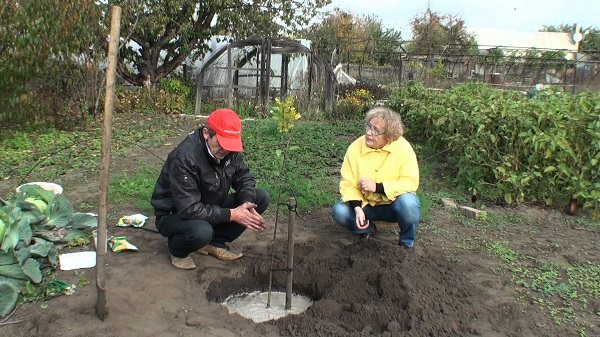

Features of feeding
When determining the amount, type of fertilizer, method of application, the age of the tree, its variety and the development of the root system must be taken into account. If the apple tree receives an excess portion of minerals in the fall, the shoots may begin to grow out of time, the winter hardiness of the bark will sharply decrease and, as a result, the tree will freeze out.
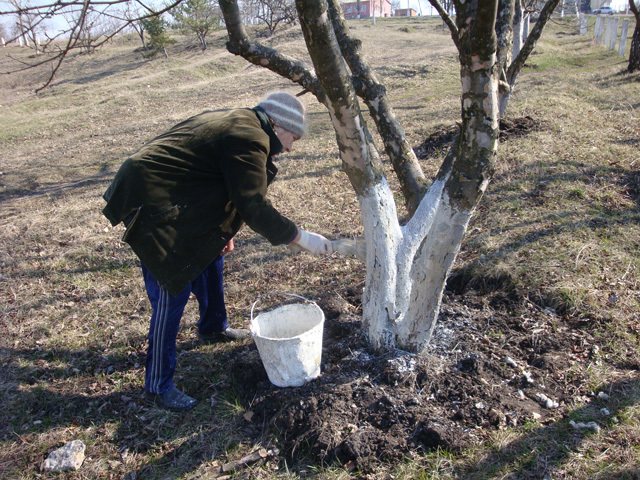

Tree age
Young apple trees, as well as seedlings, require a particularly careful approach. Do not allow large doses of non-organic fertilizers.
For mature and old trees, a different approach is required. Fertilizers are applied in holes, the depth of which does not exceed 40 cm. Depressions are dug around the perimeter.
The focus is on the variety
The variety to which the apple tree belongs also affects the amount of fertilizer applied. Today, dwarf species of this fruit crop are often found in gardens. The amount of any fertilizer used for feeding is reduced by 30% from the norm for standard species.
In columnar apple species, the root system is located quite close to the soil surface. Accordingly, the root method of fertilization is not suitable due to the high risk of compromising the integrity of the roots. The best solution is to spread the fertilizer over the surface, mix it gently with the top layer, and then water it thoroughly.


Apple tree care. Fertilization schedule
In spring, areas affected by pests or frost, old branches or not yielding crops, as well as lichen are removed. After pruning, all bare places must be treated with garden varnish so that pests and pathogenic microflora do not penetrate into unprotected places. It is necessary to whitewash the tree trunk to a sufficient height. Summer care consists mainly in watering, if the weather is very hot, and in the timely removal of fallen apples so that they do not rot under the tree.
Throughout the season, fertilizing the garden with fertilizers is mandatory. The first portion is brought in in the spring. Fertilizers are needed both organic (every year) and mineral (3-4 years after planting). It is important to remember that organic fertilizers should be made of humus, as fresh organic matter will damage the roots of the tree.
The main feeding is done in accordance with the following schedule:
- the first is the period of bud opening before flowering;
- the second - when the ovary reaches the size of a walnut;
- the next one - one month after flowering, when young shoots begin to grow;
- the final cycle of fertilizing the apple tree - in the fall, to replenish potassium and create a supply of nutrients by the tree before wintering.
Pruning apple trees in the fall. Tips from the seasoned about when to prune apple trees in the fall. Choosing the best time
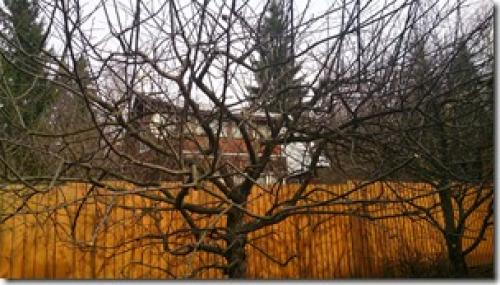

Almost every gardener has apple trees in his garden.
There are a huge number of varieties of this garden culture, apple trees grow almost everywhere, on any soil and bear fruit well.
But to achieve high productivity, apple trees need to pay a lot of attention and provide proper care.
This article will help clarify when you can prune your apple trees in the fall.
- This includes not only watering, spraying, and adding essential nutrients to the soil. An important condition for abundant fruiting is also the timely removal of excess branches, in other words, pruning.
- Weak pruning is carried out for young trees, while cutting off a fourth of the branches that have grown over the summer.
- Average pruning is carried out for apple trees at the age of 5-7 years, a third of the grown branches are pruned.
- Strong pruning is carried out for old trees, half of the branches that have grown in a year are removed in order to thin out the crown.
Apple trees, deprived of the correct formation of the crown, thicken. Leaves, trunk and roots are deprived of access to sunlight, air ventilation, and this, in turn, affects the quality and quantity of fruits.
Also, old plants are pruned for the purpose of rejuvenation, because over the years, old branches cease to bear fruit. As a result of pruning, such branches are replaced by young ones.
Compliance with the peculiarities of the apple pruning procedure will guarantee the creation of a beautiful crown and an excellent harvest.
Can apple trees be pruned in the fall?
It is permissible to prune apple trees in autumn, spring and even summer. The purpose of spring pruning is to remove branches that have frozen over the winter and form a crown to increase yields.
Moreover, this procedure must be carried out before the start of sap flow and before the buds appear on the tree. In the summer, the upper part of the crown is removed to thin out and provide access to sunlight for the fruits. In winter, apple trees are pruned only in warm southern regions.
Advice! The most appropriate is, that is, at the end of the summer cottage season. Indeed, over the summer you can see both weak and dying branches, and those that shade the crown and must be removed.
During autumn pruning, old, rotten, dried branches, broken from fruits, are removed from apple trees. Branches incapable of development take a lot of energy from the tree and it becomes less productive.
Young tree branches growing vertically upward, the so-called "tops", are also subject to pruning in the fall.
They are sterile and do not produce flowers or fruits. Such branches only thicken the crown and weaken the tree. Thus, the removal of excess branches in autumn will increase the resistance of fruit trees to severe frosts and they will winter well.
When are apple trees cut in autumn?
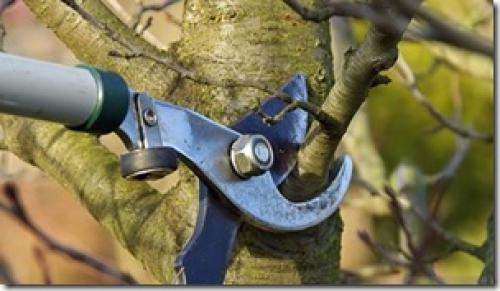

In order not to make mistakes during autumn pruning, it is important to choose the right time. The most favorable period is the time when the foliage will fall off the apple tree and the growth of shoots will stop.
The air temperature should still be positive, but there should be at least two more weeks before the first frost.
In order to correctly answer the question of when to prune apple trees in the fall - in what month, you need to take into account several factors. Much depends on the climatic conditions of the area.
For central Russia, this is mid-October - early November. The tree is already entering a dormant period, but it can still cope with pruning wounds.
It is important that the pruning takes place on a dry, sunny day. It is undesirable that the processing of the tree took place during the rain or immediately after it.
A few days after pruning, the apple tree should be inspected and watered abundantly.
TIP: You can add organic, phosphorus and potash fertilizers to the trunk circle. This will increase the resistance of the tree to frost. More about.
Attention! It is necessary to finish pruning before the first frost, since frozen sections are difficult to heal, they can begin to rot and the tree will not have time to recover before the cold weather. Pruning in winter can kill the apple tree.
Pruning schemes
The pruning scheme for apple trees is not very complicated. You just need to know a few rules to get the maximum effect.
Depending on the age of the apple tree, there are the following autumn pruning schemes:


Pruning Scheme Option # 1 for trees 1-4 years old.


Option pruning scheme No. 2.
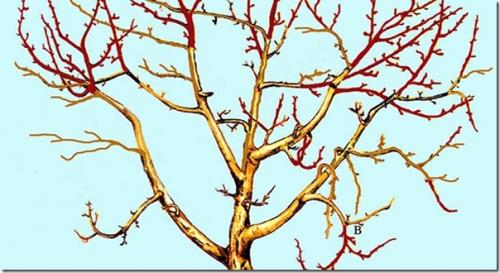

In the figure, branches for pruning are marked in red.
Useful
This video will tell you when it is better to prune fruit - in spring or autumn?
And on this video, see tips and secrets for the autumn rejuvenation of the apple tree:
If you are interested, then read oi.
Conclusion
Autumn pruning is one of the must-haves in apple tree care.
Thanks to her, fruit trees rejuvenate, get rid of pests, and improve the appearance of the crown.
As a result of correct and timely autumn pruning, any gardener will be able to get a full harvest of large and tasty apples.
Types of dressings
The apple tree reacts well to both mineral components and organic substances.
Organic
- Fresh manure. It is best used for digging an apple tree in spring and autumn. You will need about 10 kg of fertilizer per square meter of land. You can also use mullein during the entire growing season of the apple tree, which is diluted with water in a ratio of 1:10.
- Horse manure (semi-rotten). With such a fertilizer, you need to be careful, since it contains ammonia. The latter, as you know, can harm the root system if applied in large quantities, especially when it comes to young fruit trees (up to the 3rd year after planting). You can get rid of ammonia by letting the manure first lie down for three to seven days. Or, in order not to risk it, use humus.
- Humus. This is organic matter, which consists of rotted remains of animal and plant origin, for example, the same manure. Such fertilizer will no longer damage the apple tree rhizome, so it can be used without fear. The rates of application of the substance under discussion under an apple tree are similar to manure.
- Bird droppings. It is recommended to use dry bird droppings as fertilizer. It is better to apply such a heel during the first spring digging procedure. It is important to remember that this substance contains a large amount of nitrogen.In this regard, it is necessary to carefully apply it in the fall, so as not to activate the rapid growth of green mass, shoots near the tree before winter, as well as in spring, when you can leave burns on the roots of young and still weak trees. As a liquid fertilizer, you can use a solution that includes 15 liters of water and 100 g of poultry droppings. Such a feeding solution should be infused for 6-10 days before use.
- Wood ash. It is an excellent fertilizer for apple trees, as it can deacidify the soil, thereby protecting the tree from insect attacks and damage by rot, fungal diseases. Ash as a fertilizer may well replace purchased potash fertilizers.
- Bone flour. Organic, which contains a large amount of nitrogen and calcium. Many gardeners use it as a soil deoxidizer. A fertilizer such as bone meal has a beneficial effect on the apple tree if it is applied in spring and summer. Today, you can buy ready-made bone meal in any specialty store in powder or liquid form. The dosage is detailed on the packaging of each product.
The application of organic fertilizers for fruit trees is clearly demonstrated in the video:
Minerals
Despite the wide popularity of organic matter as fertilizer, mineral dressings are also often used. Their advantage is that the products are not able to provoke fungal pathologies in apple trees, and also do not contribute to the growth of weeds in the near-stem circle. Of course, where the soil is completely depleted, organic components cannot be dispensed with, but if you learn to harmoniously combine both types of fertilizers, a positive result will not be long in coming.
- Urea. Top dressing with nitrogen content is applied under apple trees in spring. This helps the fruit tree to grow a beautiful, healthy and lush crown. Also, some gardeners apply nitrogen-containing fertilizers in the summer, thus provoking the active formation of fruit ovaries. It should be understood that the lack of nitrogen will affect the foliage of apple trees, which will gradually turn yellow and fall off. But an excess of the substance will negatively affect the quality characteristics of the fruits and yield in general.
- Phosphorus (Simple Superphosphate). Experienced gardeners know that phosphorus in the amount required by the apple tree is not present in almost any organic fertilizer. And without it, the tree will not be able to fully assimilate nitrogen. In this regard, it is recommended to jointly apply phosphorus and fertilizers of organic origin under the apple tree. This substance helps to improve the development of the root system of fruit crops, as well as to accelerate flowering and, accordingly, fruiting.
- Potassium. It is especially important for young apple trees for proper growth and development. For mature trees, this substance is also very useful, as it helps to more easily endure summer droughts, as well as winter frosts. It is best to apply potassium under the tree in the fall, then by spring it will fully dissolve in the soil and start working. Gardeners recommend such potash fertilizers: potassium salt, potassium sulfate, potassium magnesium.
It is permissible for a wave to introduce into the soil the main components discussed above. But the combination of mineral and organic fertilizers will be more effective.
BioGrow biofertilizer is an effective universal top dressing. It is widely known among experienced gardeners and has many positive reviews. The product allows you to increase yields by 50%, protect plants from pests and diseases, and accelerate germination.
You can read more about BioGrow HERE.


Terms of feeding
Top dressing of an apple tree in autumn refers to the last fertilization for the fruit and berry season. It falls on the first days, immediately after the apple harvest, but until the soil is still warm, and the garden culture has not finally passed into a state of dormancy.
Usually, feeding is planned 2-4 weeks before the expected frost.
The approximate time frame depends on the region:
- Ural and Siberia - last week of August - September;
- central and middle lane - second half of September;
- southern regions - including October.
It is worth being guided by the rule: an early autumn procedure is more effective than a belated one. With late application, the culture may not have time to absorb nutrients and use them, and before the onset of spring, most of them will be washed out of the soil layers.
What trace elements are needed for an apple tree
For a rich harvest, regular apple tree care is required, which includes fertilization and feeding. For this, organic matter, mineral fertilizers and trace elements are used.
Organic matter saturates the apple trees with potassium and nitrogen, which are needed for the active growth and development of the tree, the formation of the crown. Phosphorus fertilizers are needed for the development of the apple tree root system.
Often soils are poor in substances such as salts of iron, zinc, copper, boron, sometimes magnesium and manganese. A deficiency or excess of trace elements adversely affects the growth and development of the tree. For full fruiting, add:
- Nitrogen... If it is not enough, then the leaves become smaller, lose their color, and the fruits decrease.
- Phosphorus... Due to its lack, the leaves also become smaller, plus the shortage affects the number and size of fruits. The trees have poor foliage and poor branching.
- Magnesium... Signs that he is missing it: yellow or purple leaves with green veins, leaf fall in late summer, young leaves look like a mosaic.
- Potassium... The deficiency of the trace element leads to a change in the color of the leaves, a decrease in the size of the fruit.
- Iron... The shortage contributes to the development of chlorosis, drying of leaves and their dropping.
- Zinc... It is necessary for an apple tree to form beautiful fruits corresponding to varietal characteristics;
- Copper... If the plant does not receive it in sufficient quantity, then it begins to bush strongly, as the continuation of the shoots dry up and stop growing;
- Boron... An apple tree needs a trace element for resistance to frost. Its deficiency causes deformation and cracking of the fruit.
Calculation of the dose of dressings
The rate of application of organic fertilizers under the apple tree when planting in a hole:
- 1 kg of ash;
- 2 small buckets of humus;
- 3-4 buckets of compost;
- 1-1.5 kg of superphosphate;
- 2-2.5 kg of phosphoric flour;
- 150-200 g of potassium sulfate;
- 100-150 g of potassium chloride;
- 3-4 buckets of peat.
You can mix all these compositions and feed the earth with a bucket of the resulting composition.
Trees are planted in autumn 20 days before the ground freezes. Then they are watered abundantly and the trunk circle is mulched.
Mineral fertilizers are applied dry or diluted
Both organic and mineral fertilizers are placed under the apple trees in the fall.
Thoroughly rotted manure is poured under the tree trunk circle of the apple tree. If the apple trees are young, then 10 kg is enough for them. If the apple tree is already 10 years old, then it needs about 60 kg.
Potassium and phosphorus should be added, depending on the composition of the soil. During autumn digging to a depth of 10-15 cm, approximately 12-15 g of potassium and 10-15 g of phosphorus are poured under one tree.
Before applying mineral fertilizers, the soil is watered abundantly, and after application, the dug soil is poured. Or you can pour 1 tbsp into a bucket of water (10 liters). a spoonful of potassium, 2 tbsp. tablespoons of double granular superphosphate, mix and pour a bucket of composition for 1 sq. m.
Why and when
To a person who is far from horticultural everyday life, the cultivation of fruit trees seems to be quite a simple matter: he stuck a seedling, watered and collect bulk fruits in a couple of years. This approach of an experienced gardener will only make you grin. Every summer resident who loves his work understands: to get a truly tasty, juicy fruit, you need to work hard. And fertilization of bushes and trees is a prerequisite for obtaining a full harvest. But not everyone knows about the value of autumn feeding. Fertilization in the spring is a reasonable and familiar business on the eve of flowering.And in the fall, the harvest is harvested, the growth processes slow down, and the question of feeding is not so obvious. At the same time, preparing the tree for winter, saturating it with the necessary substances, making it more resistant to frost means taking care of the future harvest today. This moment is especially relevant for regions with long and harsh winters.
After harvesting, inspect the tree, rid it of old and unnecessary branches, treat the cuts with a special solution, treat the bark from the pest. Now you can start making the autumn top dressing.


Before fertilizing, carry out autumn care: trim and process old branches so that the tree does not have to endure frosts with an extra "load"
The right time
The main thing is to get down to business on time and not to postpone the fertilization process until the onset of cold weather. In September, watering of the tree is already stopped to maintain winter hardiness. Until the moment when the snow falls and the ground freezes, there are still a few weeks. This time should be just enough for the plant to have time to absorb and assimilate the introduced nutrients, and entered the winter full of strength. Cold, frozen soil does not contribute to the active work of the roots, and the tree, introduced later than the fertilization period, simply does not have time to process. Therefore, it is best to take on the introduction of autumn dressing 3-4 weeks before the onset of frost.
Phosphorus-fortified compost
Opponents of chemical fertilizers have long used natural phosphorus, preparing compost in a special way. What is the highlight of this product? Miracle plants are added to the usual compost available on the plot of each gardener. The beauty of them is that they contain phosphorus in huge concentrations. What natural accumulators can be added to the compost heap, how much phosphorus is in them:
- wormwood 1% phosphorus;
- creeping thyme 0.7%;
- feather grass 0.9%;
- hawthorn 1%;
- rowan berries 1%.
The rules that must be followed in order for the introduction of phosphorus to be effective:
- Granular phosphorus cannot be taken and simply sprinkled under the apple tree. It is brought in only for digging. Deep holes or grooves are used. Only in this way will the mineral reach the roots.
- Phosphorus is the worst soluble in water. Therefore, it is high time to use it in the fall. Until spring, he will have time to go into a form easily digestible by apple trees.
- Phosphorus takes time to show the result. Therefore, the effect of its introduction will become noticeable only after 2-3 years.
- If the soil has an acidic pH, then ash is added to the soil in advance at the rate of 250 g per 1 m2. You can apply 500g lime per 1 m2. This procedure must be carried out one month before the phosphorus fertilization.
Tips & Tricks
We suggest that you familiarize yourself with the recommendations and advice of experienced gardeners who have been growing apple trees for several years:
- there is no need to follow the principle “more is better”. In the case of fertilizers, this strategy does not work. Adding too much nutrients is sometimes even worse than forcing the tree to endure a nutritional deficiency. It is necessary to follow all the recommended dosages, and when using purchased drugs, strictly adhere to the instructions for use;
- it is best to determine in advance what type of soil on the site: loamy, sandy, clayey. A special test or litmus paper can help in this;
- in the fall, when the rains are frequent and prolonged, it is permissible to apply fertilizers under the apple trees in an explicit, dry form, without preparing the feeding mixture, since the rain will dissolve the substance on its own;
- If you collect cut grass, dry tops and fallen leaves in one place - a kind of compost heap, then it will become a wonderful free source of organic fertilizer, in particular, for apple trees.
Feeding rules
You can feed apple trees in the fall in one of the available ways, the choice of a fertilizing complex depends on it. For any of them:
- food is brought not directly under the trunk, but having retreated from it 0.5-0.7 m, at this distance the roots are located, which will absorb minerals;
- small amounts of fertilizers are buried in the ground or scattered around the perimeter, followed by digging to a depth of 10-15 cm, i.e. 1/2 bayonet shovel;
- trees are fed only in moist soil, therefore, after the introduction of nutrient compositions in a warm and dry autumn, watering is mandatory, especially with granular complexes.
Top dressing for young (not yet fruiting) and for adults (over 5-8 years old) apple trees are different.


Apple trees painlessly survive the winter if properly prepared in the fall.
For young trees
In the fall, you need to feed young apple trees with preparations containing phosphorus and potassium.
Mineral nutrition for a non-fruiting horticultural crop should include these two basic elements. Young seedlings are fed only with liquid, previously diluted in water, fertilizers, usually using:
- a solution of superphosphate (2 tablespoons), potassium sulfate or potassium sulfate (optionally, 2 tablespoons) per 10 liters of water;
- a complex preparation - potassium monophosphate in the calculation of 10 g per 10 l of water;
- with an ash solution (200 g of wood ash per 10 liters of water).
Application standard - 10 liters of working fluid per m².
For mature trees
Old fruiting apple trees require a higher concentration of active substances, therefore the proportion of components for them increases.
They can be fed:
- a solution of superphosphate (4-6 tablespoons), potassium sulfate or potassium sulfate (optionally, 2-8 tablespoons) per 10 liters of water;
- complex composition - potassium monophosphate (15 g per 10 l of water);
- dry wood ash 250 pcs / m².
Application standard - 10 liters of working fluid per 1 m².
Old trees respond well to slurry fertilization.
For better care, it is used as an additional top dressing simultaneously with the introduction of mineral and organic nutrition.
- Manure or chicken droppings fill the barrel by 1/3.
- The volume is topped up to the brim with water.
- The mixture is kept for 3 days, stirring occasionally.
- The slurry is diluted with water in a ratio of 1: 5, if chicken manure was used instead of manure - in a ratio of 1:10.
This solution is poured over the trunk circle.
Nutrition into the wells
You can feed mature trees by applying liquid fertilizer to the holes:
- grooves are made along the perimeter of the trunk circle to a depth of 0.2 m;
- 1-2 liters of slurry are poured to the bottom;
- sprinkle with earth.
The hole method can also be used when applying granular fertilizers:
- only ½ glass of dry composition is laid out in the holes;
- sprinkle with earth;
- the remaining half of the seven is poured on top, mixed with a layer of earth;
- the fertilized soil is watered.
Feeding the roots
Autumn feeding is carried out using root methods. For this, useful funds are introduced into the trunk circles. Gardeners use two main types:
- Circular ditches. Special furrows up to 40 cm deep are dug under the apple tree. They are made around the trunk at a distance of up to 1 meter. The furrows are cut in 2 or 4, making them 30-40 cm wide.The distance from the trunk to the first furrow depends on the age:
- for young apple trees up to 5 years old -60 cm;
- for trees 5-10 years old up to one and a half meters;
- over 10 years old - up to 2 meters.
The more grooves you make, the better results you will get. Liquid mixtures are poured into prepared grooves. Top covered with compost and garden soil. After 2-3 years, a new circular ditch is dug and everything is repeated anew.
- Focal. With this method, pits are formed along the periphery of the crown. Their depth can be up to 40-50 cm.
- For solid fertilizers, remove the top layer of earth to a height of 2 cm. Spread the granules evenly. Fall asleep with mulch, compost, a little earth. This is done so that the feeding quickly reaches the small active roots.
The most effective way has become the combined one.Mineral fertilizers are applied simultaneously with organic matter to a depth of 40 cm into grooves or depressions.
Apple siderata
Some gardeners like to feed with green manure. This type of fertilizer involves digging up the ground with green, freshly cut green manure grasses. They provide the plant with nutrients, nitrogen. You can find out about siderates in this section.
The procedure is suitable for early spring or summer. Siderata are legumes, peas, alfalfa, buckwheat and others. One of the most popular articles on the site is about green manure - Phacelia as a green manure and an article on when and how to sow and dig up mustard.
What is important to do before fertilizing?
Preparation of a tree for wintering begins with cleaning procedures. First of all, they examine the trunk for the presence of moss and lichen on the surface. If available, they are carefully cleaned off, having previously covered the ground around the apple tree with a film, newspaper.
Another must-have is sanitary pruning. Dry, broken, with signs of a disease are removed. Necessarily the places of the cuts are treated with garden varnish. Also, this substance is used when various defects are found on a tree.
Specialty stores offer antiseptics. They should be in the gardener's arsenal. Protection from mold and fungi is no less important for preparing a tree for winter than feeding apple trees in autumn. After the antiseptic is completely dry, the trunks are whitewashed. This will protect the trunks not only from rodents and pests, but also from the rays of the sun reflected by the snow and can burn the trunk.
Step-by-step instructions for applying dressings
We must not forget that dressing is poured in the fall only after all other operations. First, they cut off old and damaged branches, then dig up the ground, mulch it, then add nutrients.
Before feeding trees in autumn, they need to be sprayed with a 2% solution of copper sulfate to protect them from fruit rot and scab.
When feeding young apple trees, put diluted funds under the trunk circle. Manure is introduced in the form of a solution of 1 part and 10 parts of water. Apply it carefully so as not to harm the roots due to the excess amount of mullein. Manure improves the structure of the earth.
Chicken droppings promote crown growth. It is poured dry or infused with water. For liquid feeding for 1 part of chicken manure, add 15 parts of water, and then leave for 7-10 days, wait until the composition is fermented and used.
A smaller mass of manure and other dressings are added under dwarf apple trees. Procedure:
- Spray the branches with vitriol;
- Pour manure under the trunk circle;
- Organic feed should be well rotted;
- Holes are pulled out near mature trees and fed on them;
- Then the soil is mulched.
You can not feed columnar apple trees in the holes.
With the right fall dressing, you will prepare your trees for winter and contribute to a good harvest next year.
Fertilizers for a planting pit under an apple tree
A mistake is often encountered when a gardener for an apple tree makes an unnecessarily deep hole, about a meter deep, or even more. If you apply nitrogen-containing fertilizers to such a depth, then the roots of a young seedling simply will not reach the nutrients. As for phosphorus, it, getting too deep into the ground, gradually loses its properties and becomes indigestible for plant crops. By and large, only potassium will remain active at the depth of the soil. But, as mentioned earlier, the roots of a young tree will not reach it.
If, in the process of planting an apple tree in the spring, you carry out the correct fertilization of the soil, then within the next year the tree will not need additional fertilizing.
To plant an apple tree seedling, a pit with dimensions of 50 cm x 50 cm is quite enough.About the bottom, you need to pour about 2 glasses of ash or 10 grams of potassium-containing fertilizer.Then you should add black soil or garden mixture. 20 grams of superphosphate is also introduced here. As a result, about 10-15 cm should remain free. And just this space can be filled with the main nutrients for the seedling. To fill the top layer, mix the potting mix and humus in equal parts. After that, any complex fertilizers that are sold in specialized stores are also introduced here.
Important! Complex fertilizers can only be used during the spring planting of apple trees in the soil, as they contain nitrogen. If the planting of a young fruit tree is carried out in the fall, then such fertilizers are strongly discouraged.
When planting apple trees in the fall, feeding should be transferred to next spring. You need to take 2 tbsp. l. azofoski and sprinkle the trunk circle with it. You can also prepare a solution by combining 30 grams of azophoska and 10 liters of water. If the gardener is inclined to use organic matter to fertilize the apple tree, then manure can be used, which is spread around the tree as mulch. It is also permissible to sprinkle fresh manure with top soil a little, or use the loosening method, but the layer should be no more than 10 cm thick.


Top dressing of apple seedlings in the spring. In the spring
Usually, the planting of apple trees begins at the end of April, when the ground has already thawed and warmed up. Most of all, this tree loves light loams, on which it grows well, and quickly enters the fruiting period. But if there is too much clay in the soil, then it becomes heavy. It needs to be lightened. And if the soil, on the contrary, is too light, then it is made heavier. Therefore, when growing apple seedlings, the soil mixture is prepared several days before planting.
To fill the planting holes, you must take:
- Peat - two buckets.
- Humus or compost - bucket.
- Wood ash - 1 liter.
The depth of the hole depends on the age of the seedling and the size of its root system, but, in any case, it cannot be smaller than 70 cm.The diameter of the hole should not be less than 100 cm.
The correct planting technology is that when excavating the soil, it must be divided into layers. The upper soil horizon is reclined separately. Then there is usually a layer of dark soil, and if the site is in a lowland, you can get to the sand or clay, which are also laid separately from each other on the other side of the planting pit. In the center, it is necessary to make a mound of earth mixed with fertilizers, and plant a seedling on it. The roots should hang slightly. A tie stick is stuck nearby. After that, they begin to fill the hole, returning the excavated soil layer by layer (each layer is compacted), in the same order as when digging. By the way, the main rule of planting is to press the soil first of all to the roots, and only then to the trunk.
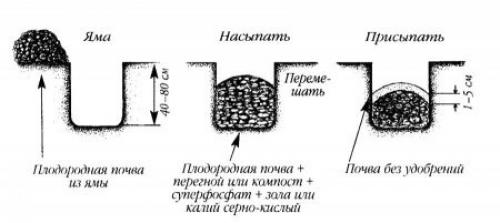

If you decide to plant a whole garden at once, then you need to correctly calculate the planting scheme. It is necessary to leave at least 3.5 meters between the seedlings, about 5 meters between the rows.
Top dressing of apple trees in the spring is primarily carried out with nitrogen fertilizers. They must be applied according to a sparing scheme, since the seedling, first of all, must take root well, and then only begin to grow actively. Spring seedlings are fed with compost tea, nettle mash, or mullein extract, diluting working solutions twice as thin as recommended. A shock dose of nitrogen is applied later, in June, under a well-established seedling.
Fertilizers for apple trees in June can be applied for young trees of the first year of life in a complex manner. For example, NPK (nitroammofosku) in granules can be used twice a season, sprinkling it on the trunk circle, followed by hilling. If you use only mineral fertilizers, then this can be limited. Organic matter is applied in the same way as for apple trees planted before winter.
Potash fertilizer
The value of potassium can hardly be overestimated.It is this mineral that helps apple trees withstand severe winter frosts. It makes them more resistant and resilient to diseases and weather disasters. A special experiment was even carried out in one of the northern cities. Under certain rows of apple trees in the winter they brought in nitrogen, but under others they did not. The result stunned the agricultural technicians. Trees fertilized with potassium in autumn overwintered well. Not a single plant suffered from severe frosts. In rows where potassium was not applied, losses after winter amounted to 50%. This made experienced gardeners love potassium with renewed vigor. Do not forget about entering it.
Potassium chloride is introduced only in autumn due to the high chlorine content. Gardeners can only benefit from this. It is best used on light sandy soils. Here it does not linger so much, it accumulates less. Accordingly, it does less damage to the soil. Potassium sulfate has become very popular. In another way, potassium sulfate.
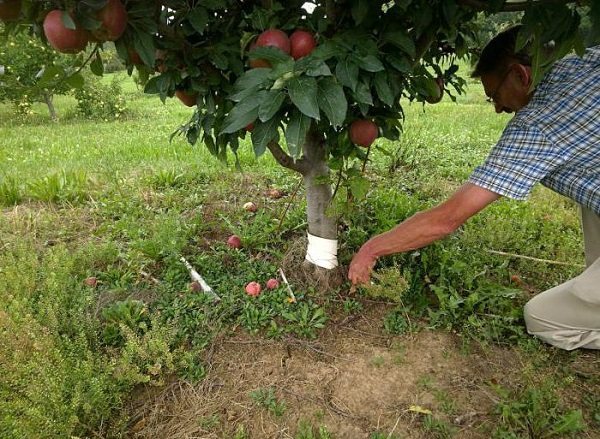

Autumn care activities
In addition to fertilizing, caring for an apple tree in autumn also includes a number of other agrotechnical measures that prepare the plant for the onset of cold weather.
- Substrate processing - moistening, removing weeds, digging. You need to loosen the ground carefully so as not to damage the roots. These procedures increase the frost resistance of the tree. Additionally, the surface should be mulched with sawdust or tree bark, which in spring will act as an additional fertilizer and protect the soil from severe freezing in winter.
- Removing diseased / old bark. A sharp piece of plastic is taken as a tool, metal knives or spatulas are not suitable for such an event. It is better to carry out the procedure after precipitation, when the bark is slightly wet. If, according to the forecast, rain is not expected, the surface is moistened independently. When the table itself is injured, the “wound” is treated with garden varnish.
- Pruning. The dried branches are removed 21 days before the expected frost, so that the cut site has time to tighten before the onset of cold weather. The recommended shape for the crown is a cone, in which the lower shoots are characterized by larger dimensions than the upper ones. Young specimens are pruned more delicately. In this case, only dry damaged segments are removed.
- Spraying to prevent diseases and prevent the appearance of insects.
- Whitewashing the trunk. Minimizes the impact of aggressive external factors, including the activity of the sun's rays, prevents damage from pests and infection of the crop. White covers the entire base of the tree, including the lower branches.
- Shelter for young seedlings. Use a burlap bag. Additionally, a frame is built so that the branches are not injured during wintering under the weight of snow.
Is it difficult to grow a garden?
When we admire a well-groomed fruit-bearing garden, it seems to us that gardening is a fairly simple activity that does not require special knowledge and skills. What is difficult?


In the spring, stick a seedling into the ground, water it well, spray it a couple of times a season - that's all the work. To people who are ignorant of the ability to plant and grow apple trees, it seems that it is very simple to have a good harvest of fruits every year. However, experienced gardeners know that growing fruit trees is a serious job that requires experience, patience and hard work.
One of the most important points in caring for an apple orchard is its competent feeding. Balanced fertilization of the soil will enable trees to develop and bear fruit normally. Moreover, the frequency of fruiting is reduced to a minimum. The tree does not get sick, it copes with pests easier, it recovers faster after such stresses as heat in summer and frost in winter.
Organic
Before the onset of cold weather, almost any organic matter can be introduced into the ground. Here is a brief description of them:
- Manure is the most popular fertilizer, the brown gold of gardeners at all times. It is brought in for digging. You cannot place fresh manure directly under the apple trees, this will burn their roots. Frequency rate of introduction every 3-4 years.
- Bird droppings are in no way inferior to humus in value. The rules are the same. The overripe fertilizer is placed in grooves or boreholes 50 cm deep. Fresh droppings away from roots. It is brought in once every 3-4 years.
- Compost. Black gold of all summer residents who use every opportunity to increase the fertility of their land. Various vegetable peelings, weeds, leaves, useful herbs, cut branches are suitable for him. It is good to season the compost with humus or droppings, alternating layers. Thanks to compost, the nutritional value of the soil increases significantly.
- Peat, containing high-quality organic matter, still retains moisture perfectly. For the best effect, mix it in half with compost.
- Siderata are the best organics on the planet with millions of experience in the wild. In winter, cold-resistant winter crops are planted in the trunk circle: wheat, oats, rye.
Organic matter is embedded in holes made with a drill to a depth of 50 cm. Humus and rotted compost are placed here. All are poured abundantly with water. You can simply push the earth apart with a shovel and pour liquid fertilizer into the holes. It is important for the shovel to have the rays. In no case across, in order to avoid damage to the root system. If the soil under the apple trees is sod, then the grass carpet is not damaged in any way. Sod squares are removed in 6-7 places. And after fertilization is closed, like a lid.
